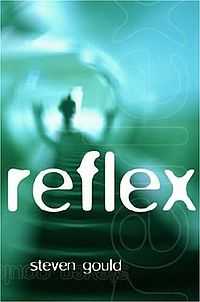Reflex (novel)
| Reflex | |
|---|---|
 | |
| Author | Steven Gould |
| Country | United States |
| Language | English |
| Genre | Science fiction novel |
| Publisher | Tor Books |
Publication date | August, 2005 |
| Media type | Print (Hardback) |
| Pages | 384 pp |
| ISBN |
ISBN 0-3128-6421-3 (hardback edition) ISBN 978-0-8125-7854-6 (paperback) |
| Dewey Decimal | 813/.54 22 |
| LC Class | PS3557.O8947 R45 2004 |
| Preceded by | Jumper |
| Followed by | Impulse |
Reflex is the 2004 sequel to the 1992 novel Jumper by Steven Gould.
Synopsis
Set ten years after the conclusion of Jumper, David Rice, a young man with the ability to teleport, has married Millie and occasionally works for the National Security Agency, only accepting jobs that he finds to be morally acceptable. During a meeting with Brian Cox, his NSA handler, Brian is killed and David is kidnapped by a powerful criminal organization with influence over the NSA and other government agencies. Millie discovers that she, too, has the ability to "jump", and sets out to find and rescue David with help from members of the NSA and, later, the FBI. The novel tells the story from David's and Millie's perspectives in alternating chapters.
Characters
- David Rice – Has the ability to "jump" instantaneously to any location that he can visualize accurately. Kidnapped and held captive throughout most of the story.
- Millie Harrison-Rice – David's wife. Shares her husband's ability, and uses it to track him down and rescue him.
- Brian Cox – David's connection to the NSA, who is murdered attempting to protect David from capture.
- Hyacinth Pope – Murderer of Brian Cox and primary tormentor of the captive David.
- Lawrence Simons – Owner of the house where David is held, and important member of the organization behind his abduction. Superior to Hyacinth Pope.
Sequel
Gould wrote a 2008 short story, "Shade", that takes place after the events in Reflex and before Impulse. It was published on Tor Books' community website.[1]
See also
References
- ↑ Willis, Jesse. "Steven Gould short story Shade @ Tor.com". SFFaudio.